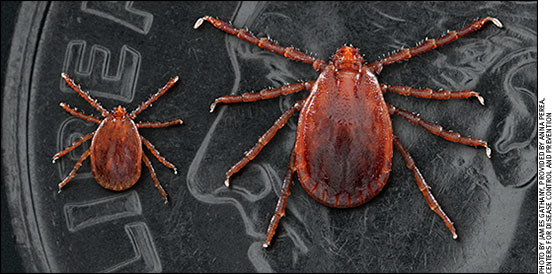
Longhorned ticks, Haemaphysalis longicornis, pictured on a U.S. dime. The smaller tick is a nymph; the other is an adult female.
Watch for New Tick
Invasive East Asian tick confirmed in six states from New York to Arkansas.
Confirmed reports of the longhorned tick, Haemaphysalis longicornis, in six states have prompted a Texas A&M AgriLife Extension Service entomologist to alert livestock producers to its possible arrival.
Sonja Swiger, AgriLife Extension veterinary/medical entomologist at Stephenville, said the longhorned tick isn’t named for the iconic bovine symbol of the Lone Star State, but rather for the distinctive, but underrated “horns” sprouting from a portion of its head.
“This tick is a relative newcomer to the United States, and though it has not been confirmed here in Texas, it has been confirmed in Arkansas,” she said. “It’s not at all choosy about who or upon what mammal it feeds on or who it dines with, as it has been found feeding right alongside other external parasites.”
Some ticks, like the cattle fever tick, prefer to complete their life cycle on a single host. Not the longhorned tick, which Swiger said is a three-host tick, meaning it requires three different hosts to complete its life cycle. Animals on the menu include, but are not limited to: cattle, white-tailed deer, horses, goats, sheep, dogs, cats, opossum, birds and raccoon.
Swiger said she has no reports of it feeding on people in the United States, though it is known to attack people in Asia and the Pacific. She did say the longhorned tick is not a known carrier of the pathogen causing Lyme disease.
“Even though there are no reports of it being a Lyme disease carrier, this tick is a known vector of several bacterial, viral and protozoan disease agents that affect both livestock and humans,” Swiger said. “So, it’s worth keeping an eye on.
“It’s an exotic East Asian tick, originally from China, which moved to Australia and then to different locations in the Pacific and eventually here,” Swiger said. “It’s highly adaptive to a broad range of climates as evidenced by the six states where it’s been documented, which along with Arkansas include New Jersey, Virginia, West Virginia, North Carolina and New York. So, it’s at home in climates from tropical to temperate and is also quite cold-tolerant.”
Swiger said it’s an aggressive biter that frequently builds intensive infestations on domestic hosts such as livestock.
“Their presence causes great stress to the animal, which translates to reduced growth and production, and exsanguination, or serious blood loss,” she said.
To make matters worse, Swiger said the tick is parthenogenetic, meaning females can reproduce without a male, so a single fed female tick can create a whole population by herself.
To prevent and offset concerns, Swiger said producers, homeowners and hunters this fall should consider conducting surveillance of ticks on their livestock, pets and harvested game and submit any suspicious ticks they find to Texas Animal Health Commission, State-Federal Laboratory and follow instructions at www.tahc.state.tx.us/vets/
TicksandFlyLarvaeSubmissions.pdf.
“If historic record is any indication, once it arrives, it appears the longhorned tick is here to stay,” she said. “But with diligence and management similar to that used with other tick species, serious trouble can be kept to a minimum.”
For more information on this and other ticks, access the Tick App at http://tickapp.tamu.edu, or contact Swiger at 254-968-4144, slswiger@ag.tamu.edu.

Editor’s Note: Steve Byrns is a communications specialist with Texas AgriLife Communications.






